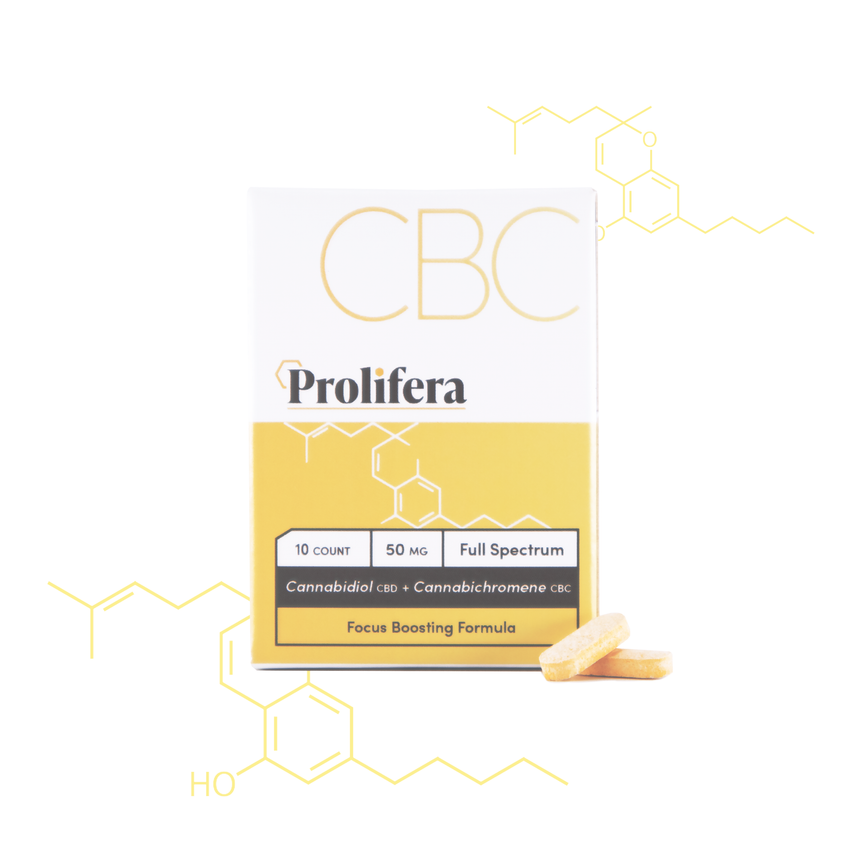What is CBC? The science behind the cannabinoid "Cannabichromene"
"What is CBC?"

Discovered over sixty years ago, Cannabichromene (CBC) is one of the most prevalent cannabinoids in the cannabis plant, yet virtually unknown to many people. CBC is not a scheduled drug and considered non-psychoactive because it does not cause a euphoric response when consumed. Plant-derived cannabinoids from both hemp and marijuana, mimic our own endocannabinoids and interact with our body. They usually bind to CB1 and CB2 receptors in our endocannabinoid system (ECS); a signaling network tasked with regulating our functions and keeping them in balance. CBC is unique in that it does not bind well to these receptors.
So how does CBC differ from CBD? CBC has the amazing ability to increase levels of naturally synthesized endocannabinoids in the body by inhibiting the natural processes that degrade them. Whereas, most other cannabinoids work directly within the ECS, binding to the receptors within it to affect your body. In essence, CBC primarily has an indirect effect on the ECS and its effort to regulate body system functions. Although much more research is warranted, this non-psychoactive compound has demonstrated effects that indicate therapeutic promise for several conditions and symptoms.
Precursor CBGA
Similarly, to cannabidiol (CBD) and tetrahydrocannabinol (THC), cannabis-derived CBC is produced from cannabigerolic acid (CBGA). It decarboxylates into cannabigerol (CBG) through a reaction with enzymes in the plant’s trichomes. When the enzyme, CBCA synthase, interacts with CBG it forms cannabichromenic acid (CBCA). The CBCA is then decarboxylated via heat and time in the chemical reaction that removes a carboxyl group, creating CBC.
THC, CBD, and CBC have similar molecular structures, having the same number of hydrogen, oxygen and carbon atoms. However, each is arranged and bonded slightly differently. These molecular distinctions cause the compounds to interact various ways with the body’s receptors thereby producing varied effects.
Interacting in The Body
CBC does not bind to CB1 receptors and is an agonist at CB2 receptors in our ECS. However, it is unique in that it also interacts with a variety of other receptors and channels outside of the ECS such as vanilloid receptor 1 (TRPV1) and transient receptor potential ankyrin 1 (TRPA1). Both help regulate our body’s homeostasis through a variety of chemical responses and are linked to pain and inflammation signals in the body. This accounts for why CBC may be quite effective when it comes to pain management. A healthy ECS system means fewer health issues and is one of the reasons to consider adding CBC to your regimen.
CBC enhances the receptor activity of cannabinoids that are naturally synthesized in your body by activating the TRPA1 and TRPV1 receptors and helping to release increased levels of endocannabinoids. It accomplishes this via interference with the natural processes that tend to degrade the CB1 and CB2 receptors as well as other endocannabinoids. In this way, CBC indirectly increases the activation of them and their productivity. One example is anandamide which is naturally produced in the body and helps in reducing depression, pain, and is often referred to as the “bliss” molecule. This is another reason more and more people are adding CBC in their daily regimen to support a healthy ECS system.
Entourage Effect
The synergistic effects of cannabis compounds working in unison within an organism, resulting in a stronger influence than any one of them alone is the relationship known as the entourage effect. This is true of many cannabinoids. Simply stated, the cannabinoids work better when they are combined with each other. Such is often the case with CBC. As an example, CBC is not psychoactive on its own. However, anecdotal evidence shows them to have a sedative effect, to make the pain-relieving effects of THC stronger, and mitigate negative effects when the two compounds are combined.
Potential Benefits of CBC
Anti-Inflammatory
Inflammation is associated with a wide array of health conditions including auto-immune disorders and cardiovascular disease. A 2010 study on animals found CBC initiated anti-inflammatory benefits on its own and was found in an earlier study to be less harmful than a common pharmaceutical in use. However, it also appears it may work better when combined with THC or CBD. The combination of all three produced even more amplified entourage effect.
Pain Relief
CBC has also shown potential for reducing pain in rat models. A 2011 study found that CBC stimulated pain-relieving networks and might prove useful therapeutically. CBC selectively reduces inflammation-induced gastrointestinal hypermotility in this study and works through different channels than anti-inflammatory drugs without the harmful side effects of these medications.
Anti-Cancer
An interesting finding about CBC is its potential to help prevent the growth of cancerous tumors. As mentioned earlier, CBC helps to inhibit the uptake of anandamide which keeps it in the body for longer periods of time. Anandamide is an endocannabinoid synthesized by the body that inhibits cancer cell growth. It has been shown to reduce the size of tumors in rat models. This study adds another piece of evidence to the anti-tumor efficacy of anandamide in breast cancer.
Antidepressant
A University of Mississippi study in 2010 was conducted on mice to test the antidepressant action of cannabis and the interaction between antidepressants and the endocannabinoid system. Results of this study show that CBC in addition to CBD and THC, contribute to the overall mood-elevating properties of cannabis and in addition to other cannabinoids exert antidepressant-like actions. The entourage effect shows positive results as well. When CBC is combined with THC and CBD the effects are amplified. CBC is not known to trigger unwanted side effects unlike many prescription medicines for depression.
Anti-Acne and Skin Conditions
Acne is often caused by excessive oil (sebum) production and CBC was shown to reduce the sebaceous gland production of this oil. A 2016 study with cannabis-derived CBC showed that it may also be beneficial for treating symptoms of acne. The cannabinoid also works by allowing increased levels of anandamide in the bloodstream, which contributes to keeping skin cells free of toxins.
Encourages Brain Growth
Evidence indicates that CBC helps promote neurogenesis, a process in which new brain cells are created. These brain cells are responsible for memory and learning, and researchers have found that CBC can encourage neurogenesis and increase the viability of brain cells. This suggests that CBC may be beneficial for those diagnosed with conditions like dementia, Huntington’s, Parkinson’s, and Alzheimer’s disease, in which neurogenesis is altered.

Future of CBC
The therapeutic promise of CBC is worth consideration and requires more research in humans to support its efficacy for treatment of several conditions. It may be beneficial by itself as well as combined with other cannabinoids that work together creating an entourage effect. Patients today are limited in the products available to them by state and federal laws which may prohibit use of marijuana and make testing difficult. Currently CBC is not a scheduled drug and may be derived from hemp. Although not as widely available as CBD, it is also legal to consume with relatively harmless side-effects. As laws change, new studies will emerge, and the demand will increase. Plant medicines such as CBC along with a diverse group of other cannabinoids will soon become an option for many more people.
Written by Judy Ghanem, Prolifera Content Writer


